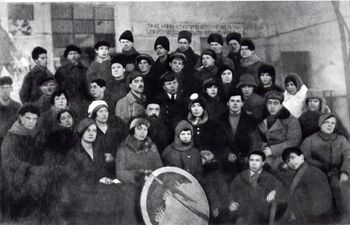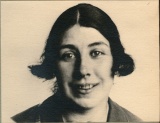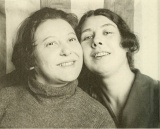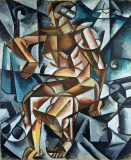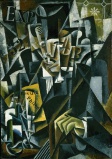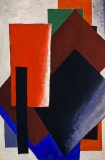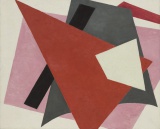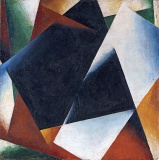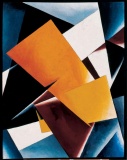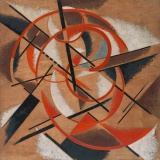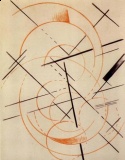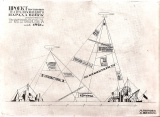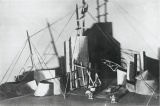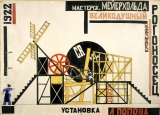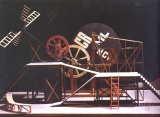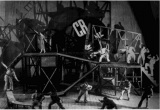Lyubov Popova
 In front of a Painterly Architectonic in her studio, Moscow, early 1919. Photographed by Alexander Rodchenko. | |
| Born |
April 24, 1889 Ivanovskoe, near Moscow, Russian Empire |
|---|---|
| Died |
May 25, 1924 (aged 35) Moscow, Soviet Union |
| Collections | Costakis, Costakis, MoMA, Tretyakov, Thyssen, Guggenheim, NGS, RGALI |
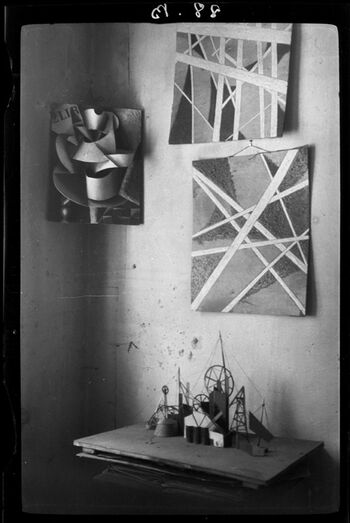
Lyubov Sergeyevna Popova (Любовь Сергеевна Попова) was a Russian Cubist, Suprematist and Constructivist artist, painter and designer.
Contents
Biography[edit]
Born in 1889 in Ivanovskoe near Moscow to a wealthy family of textile merchant and art patron. 1899 receives art lessons, paints since 11; graduates from the Arseniev Gymnasium. 1907 studies under Stanislav Zhukovsky at his studio. 1908-09 attends the art school of Konstantin Yuon and Ivan Dudin, meets Alexander Vesnin there. Autumn 1909 travels to Kiev; 1910 to Italy with her family, where she is impressed by the work of Giotto and the 15th- and 16th-century masters; summer 1910 travels to Pskov and Novgorod to study icons; 1911 several trips to ancient Russian cities including St Petersburg. 1912 works in Moscow studio 'The Tower' with Ivan Aksenov, Viktor Bart, Alexei Grishchenko, Vladimir Tatlin, and Kirill Zdanevich. 1912 visits Sergei Shchukin's collection of modern French art. 1912-13 goes with Udaltsova to Paris, where they study under Henri Le Fauconnier, Jean Metzinger, and Andre Dunoyer de Segonzac at La Palette; 1913 while in Paris she meets Alexander Archipenko and Ossip Zadkine. 1913 after spending May in Brittany with Vera Mukhina and Boris Ternovets, returns back to Russia and again works closely with Tatlin, Udaltsova and Vesnin brothers. 1914 travels to France and Italy again, accompanied by Mukhina, and discovers cubism and futurism, which she synthetises into suprematist-inspired though still kind of representational Painterly Architectonics series (1916-18). From 1914-15 her Moscow flat is a meeting place for artists (including Grishchenko, Vera Pestel, Ternovets, Udaltsova, Alexander Vesnin) and writers (including art historian Boris von Eding). 1914-16 contributes to several exhibitions, notably the two Jack of Diamonds exhibitions in Moscow (1914--making her professional debut--and 1916), Tramway V and 0.10 (both in Petrograd), and The Store in Moscow; exhibiting with Aleksandra Ekster, Udaltsova and Olga Rozanova. 1916 joins Malevich's Supremus group at Verbovka village folk centre, there she experiences a split between spiritually and materially oriented artists, finally embraces the latter and dedicates her work to poster and book design, fabric, theatre design, teaching and agitprop. 1917 makes textile designs for Natalia Davydova's enterprise in Verbovka. 1918 marries von Eding and gives birth to a son in November, next year von Eding dies of typhoid fever, she's also seriously ill but recovers. 1919 contributes to the Tenth State Exhibition: Non-Objective Creativity and Suprematism. Paints more advanced non-objective works until 1921, then releases a statement that all creative work should be for the people and making of the new society. 1920 makes stage designs for Alexander Tairov's production of Romeo and Juliet at the Chamber Theater, Moscow; teaches at VKhUTEMAS, where she organizes a program on "color discipline"; joins Inkhuk. 1921-24 entirely constructivist; designs book and sheet-music covers; sometimes works with Varvara Stepanova, Vesnin, Alexander Rodchenko. 1921 contributes to the exhibition 5x5=25 in Moscow; designs book covers, porcelain, stage sets, and textiles; makes series of Spatial-Force Constructions; teaches at the State Higher Theater Studios. 1922 creates the sets and costumes for Vsevolod Meierkhold's production of The Magnanimous Cuckold; contributes to the First Russian Art Exhibition in Berlin. 1923 designs Meierkhold's production of Earth on End; moves away from painting and sculpture and becomes completely involved with production art. 1923-24 works on textile and dress designs for the First State Textile Factory. 1924 dies of scarlet fever. 21 December 1924 large posthumous exhibition of her work opens in Moscow.
Portraits[edit]
Works[edit]
Cubo-Futurism[edit]
Portrait of Philosopher, 1915. Oil on canvas. Russian State M.
Painterly Architectonic[edit]
Painterly Architectonic (Still Life: Instruments), 1915. Oil on canvas, 105.5x69.2 cm. Thyssen.
Painterly Architectonic, 1916. Oil on board, 59.4x39.4 cm. NGS.
Painterly Architectonic, 1917. Oil on canvas, 80x98 cm. MoMA.
Painterly Architectonic, 1918. Oil on linen burlap, 70.5x70.5 cm. Thyssen.
Architectonic Composition[edit]
Struggle and Victory of the Soviets[edit]
with Alexander Vesnin, Photograph of the maquette of "City of the Future" for the mass festival Struggle and Victory of the Soviets, 1921. Costakis.
with Alexander Vesnin, Photograph of the maquette of "Capitalist Fortress" for the mass festival Struggle and Victory of the Soviets, 1921. Costakis.
Magnanimous Cuckold[edit]
Model of Popova's stage set for The Magnanimous Cuckold, 1922.
Scene from Fernand Crommelynck's The Magnanimous Cuckold, directed by Meyerhold, Moscow, 1922.
Catalogues[edit]
- Popova, 1889-1924, Moscow: Vkhutemas, 1924. Catalogue of posthumous exhibition; cover by Rodchenko. (Russian)
- Magdalena Dabrowski, Liubov Popova, New York: Museum of Modern Art, 1991, 135 pp. [1] (English)
- Exter, Goncharova, Popova, Rozanova, Stepanova, Udaltsova: Amazons of the Avant-Garde, eds. John E. Bowlt and Matthew Drutt, New York: Solomon R. Guggenheim Museum, 2000. (English)
- Popova, Madrid: Fundación Juan March, 2004, 56 pp. [2] (Spanish)
- Rodchenko and Popova: Defining Constructivism, ed. Margarita Tupitsyn, London: Tate, 2009, 190 pp. On the occasion of an exhibition at Tate Modern, 12 Feb-17 May 2009. Review: Railing (Art Book 2009). (English)
Literature[edit]
- N.L. Adaskina (Н.Л. Адаскина), "Lyubov Popova. Put stanovleniya khudozhnika-konstruktora" ["Любовь Попова. Путь становления художника-конструктора"], Tekhnicheskaya estetika [Техническая эстетика] 10 (1978), pp 17-23. (Russian)
- N.L. Adaskina (Н.Л. Адаскина), "Problemy proizvodstennogo iskusstva v tvorchestve L.S. Popovoy" [Проблемы производственного искусства в творчестве Л. С. Поповой"], in Художественные проблемы предметно-пространственной среды ВНИИТЭ. Тезисы конференций, семинаров, совещаний, Moscow, 1978, pp 57-62. (Russian)
- Miuda Yablonskaya, "Lyubov Popova", in Yablonskaya, Women Artists of Russia's New Age, 1900-1935, trans. Anthony Parton, New York: Rizzoli, 1990, pp 99-116. (English)
- Christina Lodder, "Lyubov Popova. A Revolutionary Woman Artist", Revolutionary Russia 3:2 (1990), pp 151-182. (English)
- Briony Fer, "What's in a Line? Gender and Modernity", Oxford Art Journal 13:1 (1990), pp 77-88. (English)
- Dmitrii Sarabianov, Natalia Adaskina, Popova, trans. Marian Schwartz, London: Thames & Hudson, 1991, 396 pp; New York: Abrams, 1991, 396 pp. Review: Gray (JDH 1991). (English)
- Natalia Adaskina, Dmitrii Sarabianov, "Liubov Popova", in Amazons of the Avant-Garde, eds. John E. Bowlt and Matthew Drutt, New York: Solomon R. Guggenheim Museum, 2000, pp 184-211. (English)
- Christina Kiaer, "The Russian Constructivist Flapper Dress", Critical Inquiry 28(1): "Things" (Autumn 2001), pp 185-243. (English)
- Christina Lodder, "Liubov Popova: From Painting to Textile Design", Tate Papers, 2010. (English)
- N.L. Adaskina (Н. Л. Адаскина), Lyubov Popova [Любовь Попова], Moscow: S.E. Gordeev (С. Э. Гордеев), 2010, 252 pp. (Russian)
- Patricia Railing, "Liubov Popova: Biography", InCoRM, 2010. (English)
- Petra Carlsson Redell, Avantgarde Art and Radical Material Theology: A Manifesto, Routledge, 2020, 122 pp. [3] (English)

